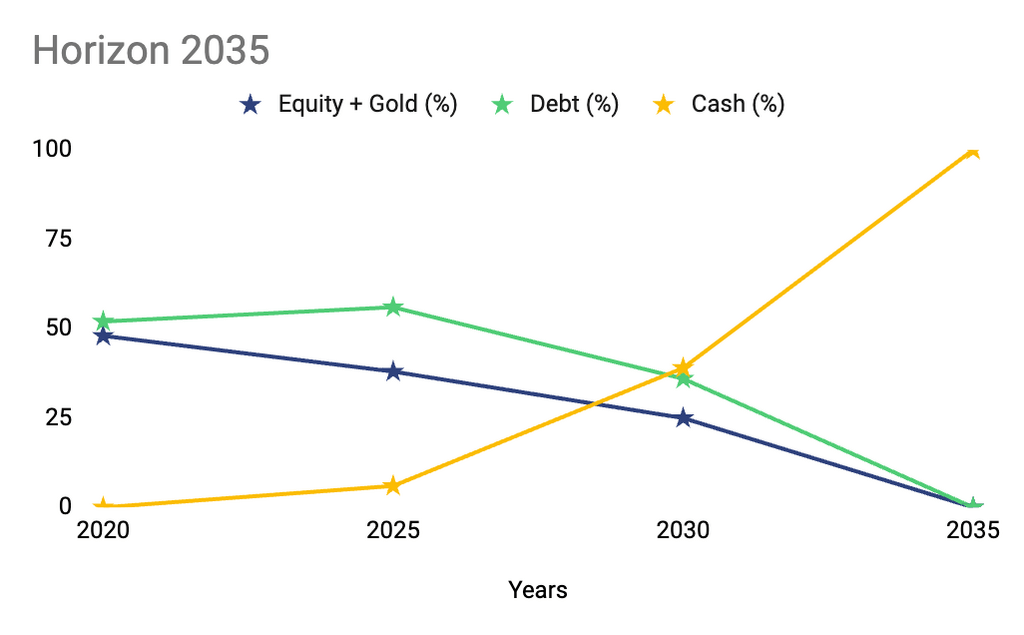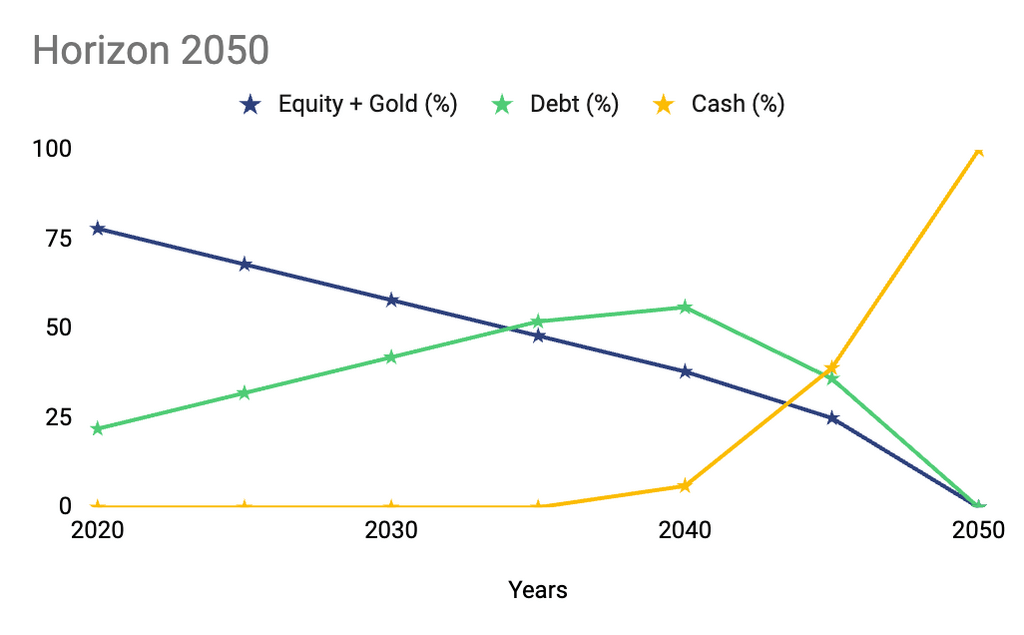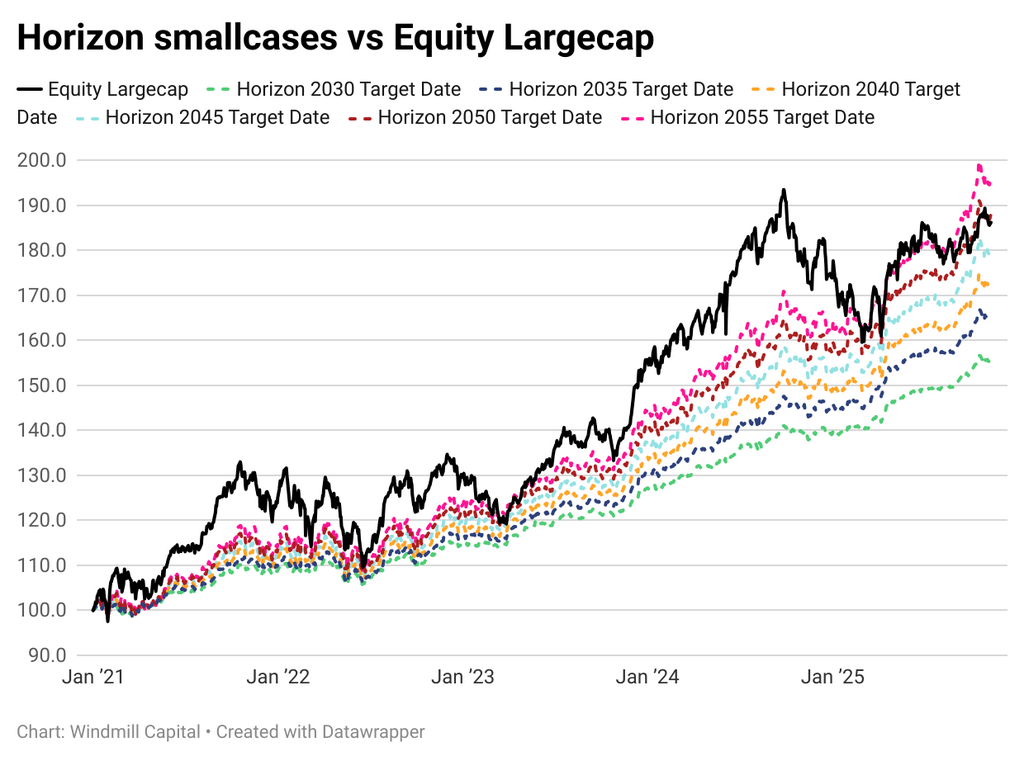How Horizon Portfolios Simplifies Goal-Based Investing

Recently, several of you asked us to explain age-based portfolios across major life stages, offering options for different risk levels. This article responds to your request. Instead of creating unspecified age brackets, we are taking a more precise approach: portfolios designed around your actual goal timelines.
Here’s the challenge most investors face: you can be aggressive early and risk a market crash near your goal, or you can play it safe and let inflation reduce your returns, the middle ground, rebalancing your portfolio regularly as your goal nears. Sounds simple, but it rarely happens. Life gets busy, markets distract you, and before you know it, you have an unoptimized portfolio with just 5 years left for withdrawal.
Horizon smallcases addresses this with glide-path investing. Your portfolio shifts from capital growth to capital protection as your target year approaches, without you needing to do much beyond an annual rebalance order and SIP orders. Whether you’re 25 and planning for retirement in 2055 or 45 and building a corpus for 2035, the timeline determines your risk level.
Why Traditional Approaches Fall Short
- The aggressive investor issue: You chase equity returns for 15 years, then a bear market hits two years before you need the funds. Panic ensues. You either sell at a loss or push back your goal.
- The conservative investor issue: You keep everything in debt early on, protecting capital that didn’t grow enough to meet your actual goal amount.
- The DIY rebalancer issue: You plan to shift 10% from equity to debt every two years. But tracking this, executing it, and staying disciplined? Most people abandon the plan after the third year.
Horizon portfolios eliminate these setbacks through systematic, rule-based allocation that automatically adjusts according to your timeline.
How Glide-Path Investing Works
Think of it like an automatic transmission for your investments. Initially, with your goal 20-25 years away, the portfolio focuses on growth-oriented assets like equity and gold to maximise returns. As your target year approaches, the allocation gradually shifts toward debt and cash equivalents, safeguarding the wealth you’ve built.
This isn’t guesswork. It’s a defined path that systematically lowers risk.
Horizon 2035: A 15-Year Journey

- Early years (2020): Equity and gold make up about 48% of the portfolio, while debt stands at 52%. The target is still 15 years away, so growth assets dominate.
- Mid-journey (2025): Equity and gold decrease to around 38%, debt rises to 56%, and cash enters at 6%. The portfolio starts to prioritise stability.
- Approaching the goal (2030): Equity and gold drop to 25%, debt remains at 38%, and cash rises to 37%. Protection becomes more important than growth.
- Target year (2035): The entire allocation transitions to 100% cash equivalents, ensuring you can liquidate your holdings immediately without market risk.
Horizon 2050: A 30-Year Strategy

- Early years (2020): Equity and gold constitute about 78% of the portfolio, with debt at 22%. With three decades ahead, aggressive growth is the main focus.
- Mid-journey (2030): Equity and gold remain strong at around 58%, debt climbs to 42%, maintaining growth while beginning to add stability.
- Final decade (2040): Equity and gold drop to 38%, debt peaks at 57%, and cash enters at 5%. The shift towards capital protection quickens.
- Last five years (2045-2050): Equity and gold decrease to 25%, then disappear entirely. By 2050, the portfolio is 100% cash, ready for immediate use.
What’s Inside: Four Asset Classes, One Strategy
Horizon portfolios diversify your money across equity, debt, gold, and cash using low-cost ETFs:
- Equity: Nippon India Nifty 50 BeES tracks India’s top 50 companies for long-term growth.
- Gold: SBI Gold ETF provides diversification and acts as a hedge during market volatility.
- Debt: Bharat Bond ETF holds AAA-rated public sector bonds for stable returns.
- Cash: Nippon India Liquid BeES offers liquidity and capital preservation.
This multi-asset approach balances risk better than traditional equity-only or mixed equity-debt portfolios.
A Real Investor’s Journey
Meet Priya, a 34-year-old professional who began investing in Horizon 2035 in February 2022 with a simple goal to build a fund for her child’s higher education. She started small, with ₹1,000, and committed to a monthly SIP of ₹2,200–2,400, tweaking it slightly as her income grew.
Here’s how her journey shaped up:
- Start: ₹1,000 initial investment in February 2022
- SIPs: Regular ₹2,500 per month
- Rebalances: Diligently followed annual rebalances in 2023, 2024 and 2025
- Top-up: Added a one-time ₹2,500 boost in February 2024
- Consistency: Missed just one SIP (July 2024)
By early 2025, Priya had invested a total of ₹1,03,550, and her portfolio had grown to ₹1,31,364 — an absolute return of 26.9% and an XIRR of 13.5%.
If she continues with her ₹2,400 monthly SIP and a modest 12% annualised return, Priya’s investment could grow to ₹6.5–7 lakh by 2035, just in time for her child’s 11th grade. The portfolio’s built-in shift to cash in the final year helps safeguard her savings from last-minute market volatility, ensuring her goal stays on track.
Choosing Your Horizon: Which Portfolio Fits Your Goal?
| Portfolio | Timeline | Best For |
| Horizon 2030 | 5 years | Near-term goals: home down payment, education fees, loan repayment |
| Horizon 2035 | 10 years | Mid-term goals: child’s higher education, second home, early retirement fund |
| Horizon 2040 | 15 years | Retirement planning, building a corpus for financial independence |
| Horizon 2045 | 20 years | Long-term wealth creation, funding children’s marriage, and retirement |
| Horizon 2050 | 25 years | Aggressive long-term goals, early career retirement planning |
| Horizon 2055 | 30 years | Multi-decade wealth accumulation, legacy building, retirement for young professionals |
Why This Approach Works
Automated discipline: You don’t have to remember to rebalance or second-guess your allocation. The glide path does it for you through annual rebalances issued by the portfolio manager—you simply place the order.
Cost efficiency: ETFs often carry expense ratios up to 1%, compared to mutual funds that can charge up to 2.25%. Lower costs mean more of your money stays invested.
Tax efficiency: Between annual rebalances, you don’t trigger tax events. When you exit, long-term capital gains rules apply if you’ve held for over a year. Each ETF has specific tax treatment:
- Equity ETFs (like NIFTYBEES): If you sell within a year, the profit is taxed at 20%. If you sell after a year, any profit above ₹1.25 lakh is taxed at 12.5%. You don’t get the indexation benefit, which means tax is calculated on the full profit without adjusting for inflation.
- Gold ETFs: If you sell within 12 months, your profit is added to your income and taxed as per your income tax slab. If you sell after 12 months, the profit is taxed at a flat 12.5%, again without indexation.
- Debt ETFs (like Bharat Bond): For ETFs bought on or after April 1, 2023, any profit—whether you sell soon or after a few years—is treated as short-term and taxed as per your income tax slab. There’s no long-term benefit here.
- Liquid ETFs (like LIQUIDBEES): Any dividends you earn are added to your income and taxed according to your income tax slab.
Flexibility without lock-ins: Unlike many mutual funds, Horizon portfolios have no lock-in period. You can withdraw whenever you need, though exiting before your target year may lead to less-than-ideal returns. If you invested above the minimum, you can make partial withdrawals. Otherwise, you must exit the full position.
Multiple goals: You can manage several Horizon portfolios at the same time—one for a home purchase in 2030, another for retirement in 2050.
Understanding the Risks
No investment is free of risk. Here’s what you should know:
- Market risk remains: While the glide path lowers equity exposure over time, your portfolio can still face volatility, especially in the early years when growth assets are more prominent.
- Timing mismatch: If you need funds earlier than planned, your portfolio may not have shifted to safer assets yet. Withdrawing during a market downturn could lock in losses.
- Rebalancing dependency: You must respond to the annual rebalance notifications. Missing a rebalance means your portfolio won’t follow the planned glide path.
- Liquidity assurance: All ETFs in Horizon portfolios are selected for their liquidity, ensuring you can exit positions when needed without significant costs.
Getting Started
- Minimum investment: Each Horizon portfolio requires you to buy all the constituent ETFs in their specified weightages. The total minimum depends on current ETF prices, typically ranging from ₹3,000 to ₹8,000. You can invest any amount above this minimum.
- SIP option: Set up systematic monthly investments at any amount above the minimum. Your SIP amount might fluctuate slightly after a rebalance as the portfolio composition varies.
- How to start: Look for available Horizon portfolios on the smallcase platform. Select the one that matches your target year and invest based on your goal amount and monthly capacity.
Frequently Asked Questions
- How does this compare to other target-date solutions?
Most target-date mutual funds in India focus solely on equity and debt, often with higher expense ratios (up to 2.25%) and less transparent rebalancing. Horizon portfolios include gold for diversification, use low-cost ETFs (expense ratios up to 1%), and clearly show how allocations change each year.
- Can I customise the glide path?
No. The glide path is set based on research and stays consistent across all investors using the same Horizon year. This ensures disciplined, rule-based investing without emotional interference.
- What if I’m more aggressive or conservative than the default allocation?
Choose a Horizon portfolio with a longer or shorter timeline than your actual goal. For instance, if you’re targeting 2040 but want more aggressive growth, consider Horizon 2045 or 2050 instead.
- How are rebalances triggered?
The portfolio manager issues a new composition annually, usually in early January. You receive a notification and must manually place the rebalance order through the smallcase platform. This process takes just a few clicks.
- What happens if I miss a rebalance?
Your portfolio continues with its current allocation, which may not match the intended glide path. You can, however, rebalance the portfolios any time before the next rebalance, but the portfolio wouldn’t generate returns as per the model portfolio.
- How have the Horizon smallcases performed?
Since their launch in Dec 2020, the Horizon smallcases have delivered superior risk-adjusted returns compared to Equity Largecap stocks. They also have significantly lower drawdowns compared to largecap equities. Max Drawdown (MDD) measures the largest fall from a portfolio’s highest point to its lowest point over a period. It shows the deepest decline the strategy has ever faced — and therefore the level of downside risk an investor must be prepared to handle.


The Bottom Line
Financial goals have become more diverse and personal. Whether you’re saving for retirement, a home purchase, your child’s education, or a career break, Horizon portfolios offer a structured, low-maintenance way to get there. By combining multi-asset diversification, systematic risk reduction, and cost-effective ETFs, they take out the guesswork and discipline challenges that trip up most investors.
Choose your target year, stay consistent with contributions, and let the glide path do the rest.
Disclaimer: Investment in securities market are subject to market risks. Read all the related documents carefully before investing. Registration granted by SEBI, membership of a SEBI recognized supervisory body (if any) and certification from NISM in no way guarantee performance of the intermediary or provide any assurance of returns to investors.
The content in these posts/articles is for informational and educational purposes only and should not be construed as professional financial advice and nor to be construed as an offer to buy /sell or the solicitation of an offer to buy/sell any security or financial products.Users must make their own investment decisions based on their specific investment objective and financial position and using such independent advisors as they believe necessary. Windmill Capital Team: Windmill Capital Private Limited is a SEBI registered research analyst (Regn. No. INH200007645) based in Bengaluru at No 51 Le Parc Richmonde, Richmond Road, Shanthala Nagar, Bangalore, Karnataka – 560025 creating Thematic & Quantamental curated stock/ETF portfolios. Data analysis is the heart and soul behind our portfolio construction & with 50+ offerings, we have something for everyone. CIN of the company is U74999KA2020PTC132398. For more information and disclosures, visit our disclosures page here.





